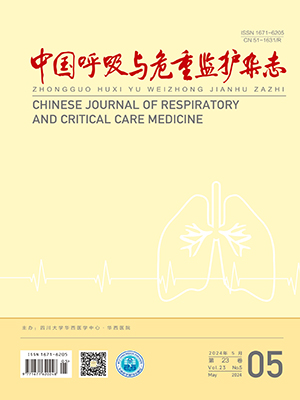| 1. |
宋莉,康焰.不同镇静镇痛方法用于抢救性气管插管的临床研究.中国呼吸与危重监护杂志,2006,5:370-374.
|
| 2. |
Crocker C.Nurse led weaning from ventilatory and respiratory support.Intensive Crit Care Nurs,2002,18:272-279.
|
| 3. |
Sztark F,Lagneau F.Agents for sedation and analgesia in the intensive care unit.Ann Fr Anaesth Reanim,2008,27:560-566.
|
| 4. |
Jakob SM,Lubszky S,Friolet R,et al.Sedation and weaning from mechanical ventilation:effects of process optimization outside a clinical trial.J Crit Care,2007,22:219-228.
|
| 5. |
Hirabayashi Y,Hiruta M,Kawakami T,et al.Effects of lightwand(trachlight)compared with direct laryngoscopyon circulatory responses to tracheal intubation.BrJanaesth,1998,81:253-255.
|
| 6. |
阳书坤,谢江霞,霍开秀,等.右美托咪啶与咪达唑仑对慢性阻塞性肺疾病急性加重期机械通气患者镇静的比较研究.中国呼吸与危重监护杂志,2013,12:481-484.
|
| 7. |
陈启江,施宗驱,薛其骏,等.右美托咪定在慢性阻塞性肺疾病急性加重合并呼吸衰竭患者无创通气中的应用.中国呼吸与危重监护杂志,2013,12:29-31.
|
| 8. |
Muellejans B,Matthey T,Scholpp J,et al.Sedation in the intensive care unit with remifentanil/propofol versus midazolam/fentanyl:arandomised,open-label,pharmacoeconomic trial.J Crit Care,2006,10:R91.
|
| 9. |
Trabold F,Casetta M,Duranteau J,et al.Propofol and remifentanil for intubation without muscle relaxant:the effect of the order of injection.Acta Anaesthesiologica,2004,48:35-39.
|
| 10. |
Nishiyama T,Furuya C,Hanaoka K.Clinical use of midazolam.Masui,1997,46:1172-1178.
|
| 11. |
Mantz J.Alpha2-adrenoceptoragonists:analgesia,sedation,anxioly-sis,haemodynamies,respiratory function and weaning.Baillière's Clinical Anaesthesiology,2000,14:433-448.
|
| 12. |
Yildiz M,Tavlan A,Tuncer S,et al.Effects of dexmedetomidine on haemodynamic responses to laryngoscopy and intubation:periopertive haemodynamic and anesthestic requirments.Drugs RD,2006,7:43-52.
|
| 13. |
Akada S,Takeda S,Yoshida Y,et al. The efficacy of dexmedetomidine in patients with noninvasive ventilation:a preliminary study.Anesth Analg,2008,107:167-170.
|
| 14. |
Stamenkovic DM,Hassid M.Dexmedetomidine for fiberoptic intubation of a patient with severe mental retardation and atlantoaxial instability.Acta Anaesthesiol Scand,2006,50:1314-1315.
|
| 15. |
Breen D,Karabinis A,Malbrain M,et al.Decreased duration of mechanical ventilation when comparing analgesia-based sedation usjng remifentanil with standard hypnotic-based sedation for up to 10 deys in intensive care unit patients:a randomized trial.Crit Care,2005,9:200-201.
|




